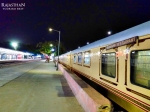
Like too much of studies or being into the books may lead to stress, similarly too much of play might also lead to stress. So our very own Rajasthan Royals team took off for a trip into the wild.
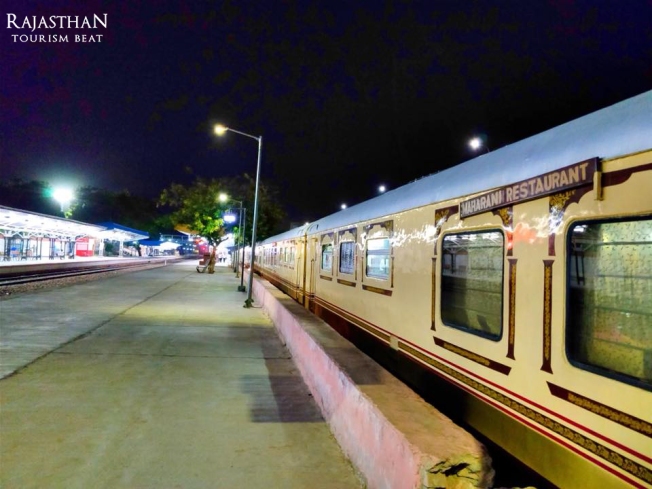
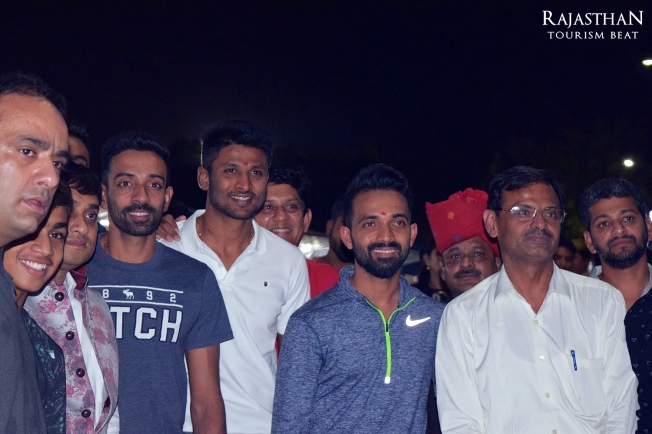

Like too much of studies or being into the books may lead to stress, similarly too much of play might also lead to stress. So our very own Rajasthan Royals team took off for a trip into the wild.


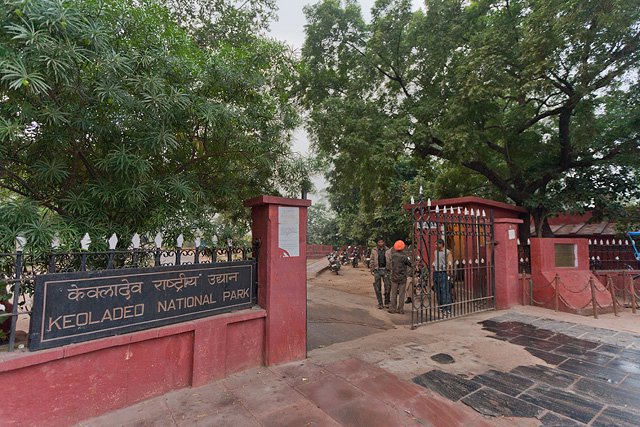
Keoladeo National Park is one of the historical national park in India that welcomes thousands of tourists every year due to the attraction of migratory birds. The park offers a joyride on boat to the tourists so that they can enjoy watching birds from close. But not any more. Owing to the decreased level of water in the lake, tourists visiting Bharatpur’s Keoladeo National Park will not be able to enjoy boating, one of the main attractions at the sanctuary.
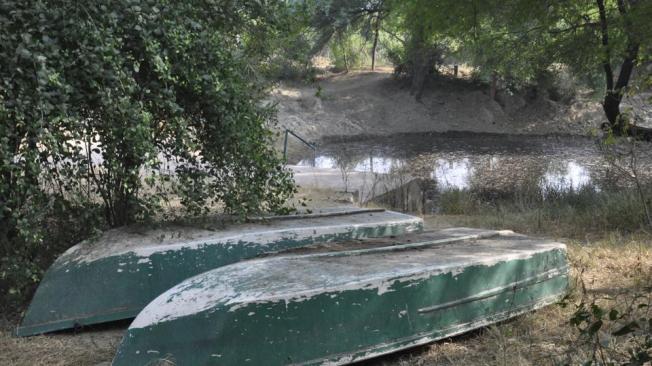
Image via HT
A World Heritage Site, the national park has been facing lack of water due successive scanty monsoon, hitting the breeding of local birds. The park has four boats joyrides in lake and for tourists to watch migratory birds that roost in the trees to the lake. Thousands of migratory birds from Europe, Siberia, China and Asia visit to park for nesting on the babool trees in every winter.
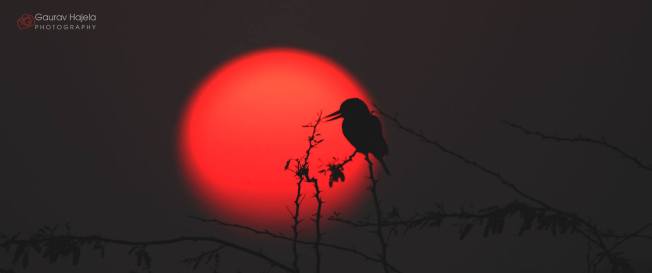
Birds, including painted stork that visit the park for nesting and breeding every year, have gone to other lakes due to shortage water, said park director Ajit Udhoi. Hence, looking at the sensitivity of the issue and scarcity of water, the officials have decided on keeping the boats at bay.
Tourists, however, can visit the park.

Jaisalmer has always been a much loved tourist spot in Rajasthan. Desert National Park in the city is a popular destination along with Sonar Quila and Tanot Mata Temple.
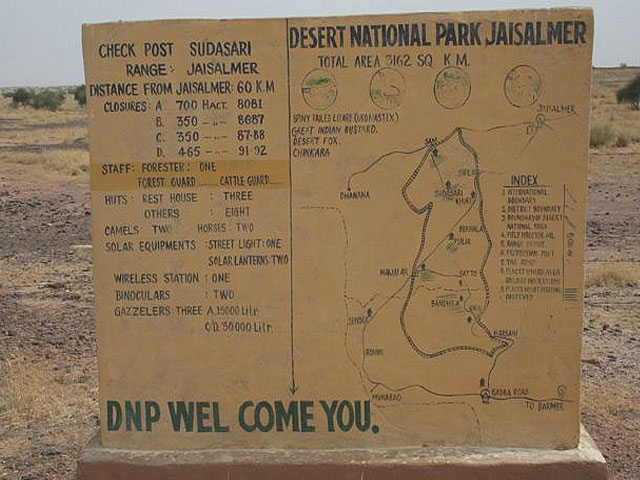
Desert National Park offers an experience that is different from the well-known desert safaris in Jaisalmer. Desert National Park is one of the largest national parks in India. The place is especially popular for a huge variety of migratory birds seen at this time of the year; Great Indian Bustard being the most popular of them. Other birds that you can spot here are eagles, harriers, falcons, buzzards, kestrel and vultures. Short-toed eagles, tawny eagles, spotted eagles, laggar falcons, sandgrouse and kestrel.
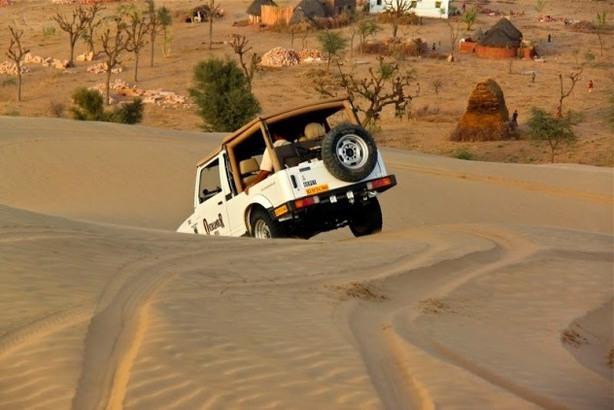
Now that the park offers a safari too, you can sight some wild animals here like Black Buck, chinkara, desert fox and cat, blue bull, desert gerbil and gecko.
The place also has a collection of plants and animal fossils which can be of interest to many people.
When a place has so much to offer, you shouldn’t miss visiting it.
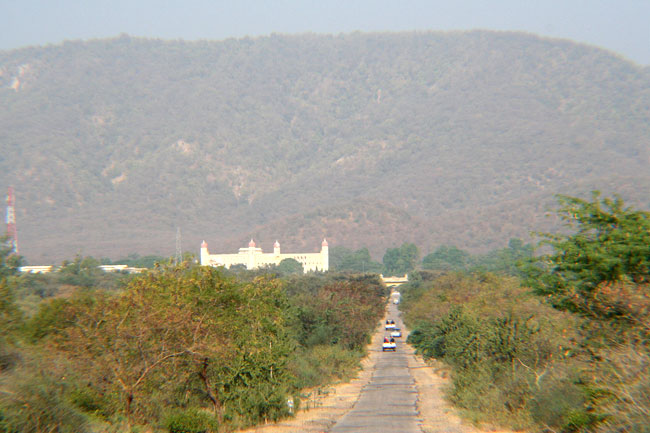
Image via Google
We remembering sharing with you some exciting reasons to go on Ranthambore wildlife safari in summer, that’s good but you should also know that visiting one of the Tiger Reserves in Rajasthan- Sariska will be costlier now.
The tiger safari in Sariska Tiger Reserve has become costlier after the recent hike. Tourists will now have to shell out Rs 1,000 more for the Gypsy safari, starting this month i.e. May, 2017. The forest department has now increased the Gypsy safari fee from Rs 3,280 to Rs 4,280, a hike of rs 1,000, from May 1. The Sariska Park has been faring badly in the wildlife safari circuit since 2005 and this new hike may take it even more down the preferred list of tourists.As it is, the park is short on tigers when compared to the more illustrious Ranthambore reserve.

With only 13 to 14 tigers compared to Ranthambore Tiger Reserve’s 60, sighting a big cat has become rare in Sariska, which is jokingly referred to as ‘buffalo sanctuary’. Instead of such price hikes, the government will have to draw up a comprehensive plan of action if it’s serious about reviving the park. The forest cover of Sariska reserve (1,100 sq km) is larger than Ranthambore Tiger Reserve, which spans over barely 392 sq km along with 60 tigers. Though Sariska lost all its tigers to poaching by 2005, it is now home to 14 big cats after relocation of tigers, distributed over a vast expanse of forest. To add to the woes, the forest department had copied the Ranthambore Tiger Reserve model and introduced three or four designated zones for tourists in Sariska.
No other province awaits rains like the desert state of Rajasthan. The first shower of monsoon is like a breath of relief and a full stop to the constant endurance of blazing heat. After a long scorching summer, a monsoon vacation is a must and to make it even more relaxing and refreshing, exploring the beauty of Rajasthan should be on the top of your bucket list. And to know why, take a look at some of the amazing and some hidden destinations of this state which become way more attractive with every shower.
Known as the Venice of East, the rains can bring the romance alive in this city of lakes. The view of clouds, the smell of rain, the greenery and royalty of Taj Lake Palace, City Palace, Sajjangarh Fort aka Monsoon Palace, Fateh Sagar Lake, Lake Pichola, Jag Mandir and their surroundings will make you fall in love all over again.
Who doesn’t love the view of lush green forests and river in monsoon? The heritage boutique hotel of Bhainsrorgarh situated on a cliff on the banks of Chambal River will give you the time of your life. Sightseeing during rains, visit to the Badoli Temple, capturing the beauty of the river and enjoy the moments of relaxation while dining on a cliff is monsoon bliss 😉
Image Credit: www.bhainsrorgarh.com
Visiting a hill station during monsoon can be your first best decision and choosing Mount Abu for the same would be your second best. It is a lethal combination of rains, amazing weather for trek, mountains, waterfalls, flora and fauna, and getting breath taking views from Dilwara Jain Temple and Nakki Lake.
Monsoon is the best time of the year to come and enjoy the natural beauty of Keoladeo National Park aka Bharatpur Bird Sanctuary since more than 350 avian species are available for bird watching. The Bharatpur Forest Lodge can be your stop to sit, feel the rain and enjoy the melodious chirping all around.
Midway between Jodhpur and Udaipur, Narlai can be your next destination. Old havelis, jeep safari for spotting deer, panthers, chital, leopards, and trekking are some of the major attractions for this time of the year.
Special for receiving greatest amount of rainfall, Bundi is also famous for the Hadoti Palace, the step wells, Nawal Sagar Lake, and beautifully carved havelis; this less explored travel destination has its own story to tell via the rains.
The rains and cool breeze would be welcoming and soothing for you to visit Kumbhalgarh fort or go out in the wild on a jeep safari in Kumbhalgarh wildlife sanctuary. This is the right weather for you to watch the real beauty of the flora and fauna that comes out with the rain.
If you are into mythology, Mahansar is the right destination for you where the sone-chandi ki dukan portray gold leaf paintings of Ramayan and life of Krishna, and to enjoy the best of it you need to take a break from burning summers and visit the place during monsoon. The greenery accompanied with cool temperature will leave you amazed.
Image Credit: www.imagesofrajasthan.com
The lakes, the wildlife, the scenic beauty and desert camping are only a few of the major attractions in Pushkar. The city comes to life during monsoons as completely different shades of Pushkar are visible in the midst of monsoon showers.
One of the hidden destinations of Rajasthan, Kuchaman has a lot in store for you especially during monsoons. The cool and refreshing weather is perfect to visit and praise the beauty of Kuchaman Fort, the cliffs, Sheesh Mahal, Meera Mahal, and Jal Mahal.
Image Credit: www.flickr.com
Another unexplored place of Rajasthan is Mandawa. The rains are a perfect time to enjoy the old havelis, paintings and open air art gallery in the Mandawa Palace.
Known for its spectacular marble Jain temple and few other temples like the sun temple, Ranakpur is ideal when admired in monsoon season. The fall in temperature makes it easier to wander and enjoy the incredible architecture.
Last yet not the least – capital city, the Pink City. Witness the Teej festival which marks the advent of monsoon along with the awe inspiring sites of Jal Mahal, Albert Hall museum, step wells, Hawa Mahal and the temples in Jaipur especially during the rains because it’s the best time of the year to enjoy the marvelous beauty of the city.
And you cannot skip the delicious cuisine of Rajasthan while going around the state and enjoying the major attractions, can you?
With the monsoon season approaching, comes a disappointing news for all safari lovers, photographers and travelers. The season for safari in wildlife sanctuary will be closing on 30th June 2016 and is expected to remain closed till 30th September 2016. The safaris and reserves of Rajasthan include Ranthambore Tiger Reserve, Sariska Tiger Reserve, Keolado National Park, Darrah Sanctuary, Sajjangarh Santuary, Kumbalgarh Sanctuary, Desert national Park, Mount Abu Sanctuary, SitaMata Sanctuary and Tal Chapper Sanctuary.
There are various safety reasons due to which the safaris in the sanctuaries of Rajasthan remains closed during this time. One of them being heavy rainfall due to which the tracks lose its shape and the water collects which may shoot up the chances of accidents. 
The other reason is that this is the breeding season for many animals. It is optimal for the survival of the young in terms of factors such as ambient temperature, water and food availability and also behavioral changes in many animals. Related interests and behaviors are expressed and accepted during this period.
Also, the growth in flora and fauna hikes up vegetation covers which spreads over the roads and tracks increasing the chances of attacks by wild animals and also the poisonous plants that grow alongside that may harm the visitors. Hence, for your safety, it will remain closed this season.
But , hey, don’t be disappointed. Rajasthan provides a wide scape for tourism. Those who want to travel must not cancel their plans due to this reason. Rajasthan welcomes you all with open hearts and wide arms. It’s a state that offers immense opportunities of exploring various cities, heritage sites, and culture . It’s the perfect time to explore all that while the sanctuaries remains closed.
For more details about the places you can discover in Rajasthan, please wait until the next blog comes up!
Khamma Ghani! 🙂
An international level Swacch drive will take place for which the centre has identified 10 iconic places with higher footfalls and tiger reserves and sanctuaries, including Rajasthan’s Ajmer Dargah Sharif which is a noted holy sufi shrine in Ajmer and Sariska Tiger Reserve. They are to be cleaned according to international standards for which the World Bank will provide technical assistance. The government plans to do the bench marking to ascertain what will be the standard of cleanliness both inside and outside these places.
Maintaining cleanliness is a major concern these days. With all the dirt and garbage on streets the beauty of real Rajasthan takes a backseat. It is worth noting that Rajasthan is one of the important tourist destinations and due to all the garbage littering around, the system is definitely affected. The dirty streets, garbage pouncing out of the garbage boxes and monuments that are into ruins need to be stopped to protect the rich heritage of the state.
The initiative to clean these heritage sites and reserves is highly applaudable. With the Swacch Bharat Abhiyan, rising concern for cleanliness among people is seen. In fact , there are various initiatives taken by people and organizations to clean the city themselves. And very proudly we can say that those efforts really proved fruitful. The city is way cleaner than before. People have also started taking care of it by not just providing a hand in cleaning but also by not spitting and throwing garbage and guiding others to stop doing the same. This has been an awakening for people so far and the results are right in front of their eyes.
This initiative by the government of Swacch drive is definitely going to help in highlighting the hidden treasures of Rajasthan and help in building a cleaner and safer state!
Once a hunting preserve of the Maharajas of Jaipur and now a Project Tiger Reserve, Ranthambore National Park or Ranthambhore is one of the largest national parks in northern India, covering an area of 392 km². It is situated in the Sawai Madhopur district of southeastern Rajasthan, about 160 km southeast of Jaipur. Ranthambore gives a unique flavor of nature, history and wildlife and houses a large number of Bengal tigers that can be easily observed hunting and taking care of their young ones during the jungle safari.
After the oldest tigress in the country – Machli celebrated its 20th birthday last week, this week the authorities have decided to assign numbers to the tigers for their easy identification. Ranthambore National Park is said to be the first park in the country to begin the tradition of assigning numbers to the tigers on the basis of photographs in the year 2009.
The first time numbers from T -1 to T – 45 were allotted in 2009 and later in 2013 from T – 46 to T -75. As some new tigers have not been spotted from a couple of days now and even the adult tigers would now be defining a particular territory to themselves, the authorities have taken a step to assign them numbers from T- 76 to T – 91 for their easy sighting and tracking.
The entire Shekhawati region has mesmerized millions of tourists and has been aptly dubbed as the ‘Open Art Gallery’ of Rajasthan. The region, which is approximately 200 kms from Jaipur is replete with palaces, minor castles, wells and also a deer sanctuary. As the region is said to be a mini desert, we advice to you travel on a horse or a camel to enjoy the semi desert feel and watch for the well preserved wall painted havelis.
How about hiking on a blissful and adventurous break at Bhangarh and discovers the secrets of the Haunted Ruins of Rajasthan along with heritage sceneries?
Flanked among three Aravali Mountains, 52 km. away from Jaipur, Bhangarh is situated in Alwar district of Rajasthan and is known to be India’s most haunted place.
The remains of Bhangarh Fort are informative enough to take you on a mesmerizing journey, of the reminiscence from the past. Entry to the place is closed after sunset due to paranormal activities reported inside. It’s just not the place, but the route also gives whimsical experience.
With a majority of blue houses, Bundi, loacted 219.7 km away from Jaipur via NH 12, is surrounded by the Aravali Hills. Lazy and narrow lanes, Lakes, around 60 step wells (Baories), temples and mosque dominate the town. Not many knew this fact that Jodhpur- the blue city and Bundi have a strong affinity to the color blue. Get to the top of Bundi Fort to get a glimpse of the beautiful Blue City. A picturesque Nawal Sagar man made lake in the heart of the town, add more beauty to the place, especially during sunset when it soaks the reflection of the two-storied fortified complex ‘Garh Palace’. Garh Palace is host to ‘Chitrashala’ where the walls and ceilings are embellished with miniature paintings. Bundi miniature paintings depicted on the walls are still in its original form.
Relatively less explored in Eastern Rajasthan, Deeg Water Palace is an awe-inspiring visual masterpiece, 192 km from Jaipur in Rajasthan.
Built in 1772, Deeg palace was a luxurious summer resort for the rulers of Bharatpur State. It is open 9 am to 5 pm except on Fridays.
Stay the night at Bharatpur, just 32 km away from here !
Rambling between the mighty Mehrangarh fort and Umaid Bhawan, the sun kissed city of Jodhpur is situated 337 km away from Jaipur. Founded by Rao Jodha in 1459, Jodhpur is dotted with soaring forts and palaces shimmering in sandstone while the narrow lanes lead to an alluring world of antiques and handicrafts. The blue of houses renders an alluring “Blue City” especially to be seen at sunrise and sunset. The other places to visit include Sheesh Mahal, and Osiyan Temple that are some of the most imposing architectural works of ancient times and the Osiyan sand dunes will take you away from all the hustle bustle. Jodhpur Sweets, Gatta, Chakke ki sabzi and Mirchibada are not be missed !
Mount Abu is the only hill station in the dry arid lands of Rajasthan, which can be reached through a 7 hour drive from the capital city of Jaipur. This hill station provides a great tourist destination owing to its picturesque land. Some of the main attractions of the city are Nakki Lake, Dilwara Temple, Mt. Abu Wildlife Sanctuary. Capture a perfect sunset from the Sunset Point in Mt. Abu J
Situated 115 km from Jaipur, Nawalgarh is better known as the ‘Open Air Art Gallery’. It is a small town where the vibrant streets depict the true blend of architecture smoothly fusing the Hindu, Mughal, Persian and British facets together. As you walk down this “Open Air Art Gallery” you will be amazed to see how the painted havelis and frescoes have captured the culture,customs and royal lifestyle of the Shekhawatis. The Roop Niwas Kothi , Murarka Haveli, Bhagton Ki Choti Haveli are some architectural gems which illustrate an impeccable mélange of Rajput and European architecture.
Situated 14 km (8.7 mi) northwest of Ajmer, Pushkar is one of the oldest cities in India and is also one of the five pilgrimage sites for the Hindu. The town has hundreds of temples, including 14th-century Jagatpita Brahma Mandir, a temple dedicated to Lord Brahma- creator of the world. People from all over the world visit Pushkar especially for Pushkar Fair, the largest cattle fair of the country. Set on Pushkar Lake, Pushkar is a sacred Hindu site with 52 ghats (stone staircases) where pilgrims bathe. You can also drive to the Dargah in Ajmer !
Once a hunting preserve of the Maharajas of Jaipur and now a Project Tiger Reserve, Ranthambore National Park or Ranthambhore is one of the largest national parks in northern India, covering an area of 392 km². It is situated in the Sawai Madhopur district of southeastern Rajasthan, about 160 km southeast of Jaipur. Ranthambore gives a unique flavor of nature, history and wildlife and houses a large number of Bengal tigers that can be easily observed hunting and taking care of their young ones during the jungle safari.
The destination pulls the attention of myriad wildlife lovers and photographers every year. The legendary Machli or T-16, is probably the oldest and world’s most photographed Tigress alive who also has a postal stamp on her.
65 kms. Away from Jaipur city, Shahpura, offers a life that is unhurried, a beautiful town of friendly people un-spoilt by the creepy fingers by modernity. The real charm lies in visiting its quaint village and experiencing a feel of authentic rural Rajasthan with all its charming eccentricity. Exquisite and discreet, the 300 years old impressive Shahpura Haveli is a tribute to the glorious past.
Ranthambore – a land of tigers is situated south from Jaipur. With approximately 3 hours distance, the famous Ranthambore National Park lies in the city of Sawai Madhopur.